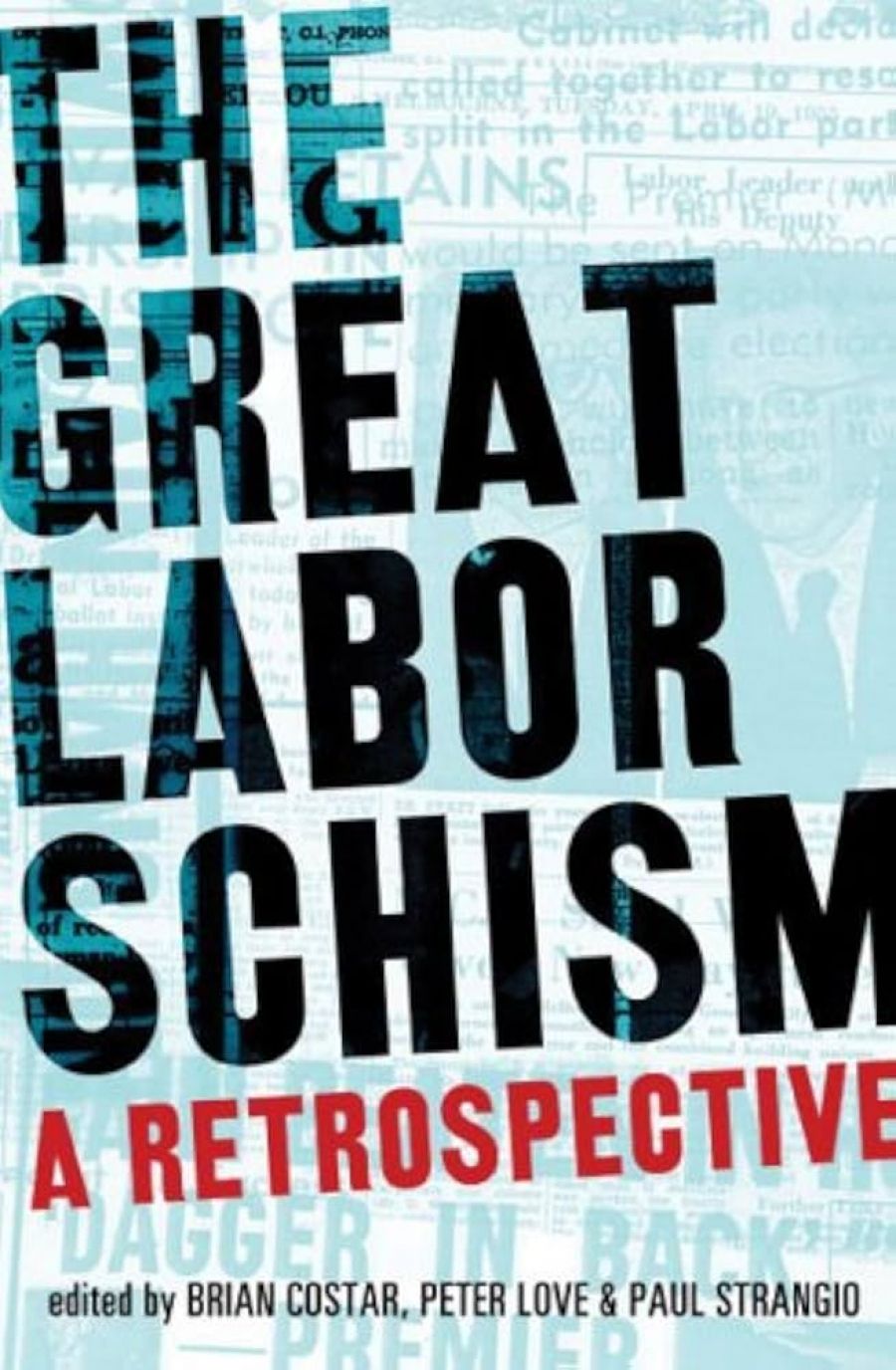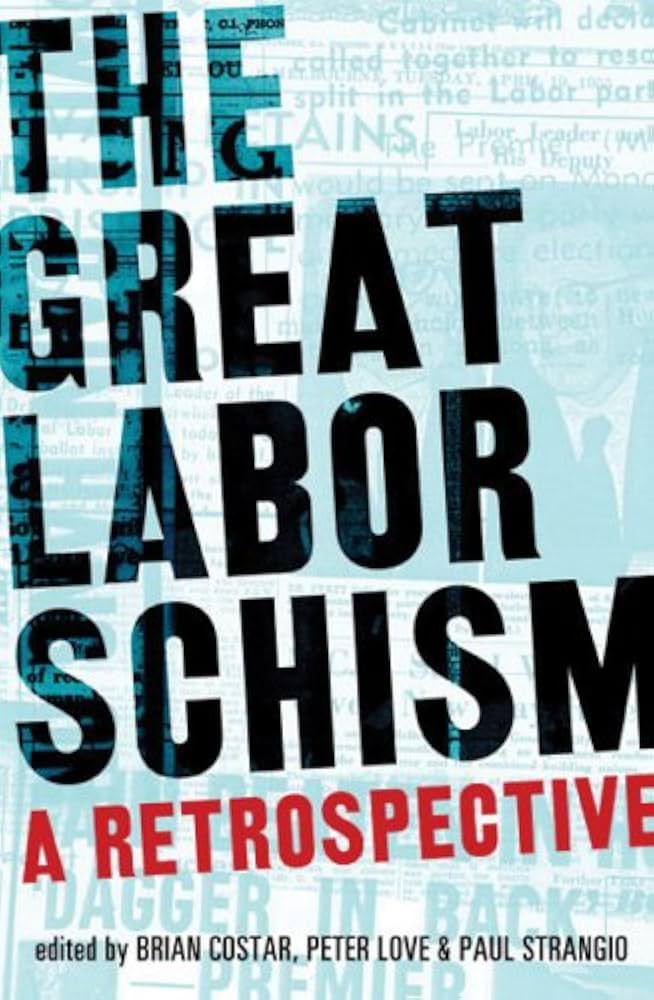
- Free Article: No
- Contents Category: Non-fiction
- Review Article: Yes
- Article Title: A bloodless tale
- Online Only: No
- Custom Highlight Text:
Fresh from celebrating one glorious misadventure in Australia’s radical history, the labour movement now confronts a more awkward anniversary. The recent 150th year celebration of the Eureka Stockade brought with it a certain self-congratulatory afterglow. Less sanguine recollections will no doubt colour the fiftieth anniversary of the great ALP Split of 1955. This catastrophe had its origins in a decade-long struggle between right-wingers combined in Industrial Groups, and communists, over union power. The legacy of this Split ran from mass expulsions in the ALP, to collapse of state governments, disaffiliation of a union bloc and, finally, to a new political party, the Democratic Labor Party (DLP), whose preferences ensured that the ALP could not win a federal election for two decades. Whatever malaise debilitates contemporary Labor, the Split remains the party’s greatest tragedy.
- Book 1 Title: The Great Labor Schism
- Book 1 Subtitle: A retrospective
- Book 1 Biblio: Scribe, $35 pb, 374 pp
- Book 1 Cover Small (400 x 600):

- Book 1 Cover (800 x 1200):

This collection of essays stands as an insightful, if uneven, reflection on the crisis of Labor during the ten years after the end of World War II. The causes of the Split, its consequences and parallels with our current hegemonic conservatism, are all considered. Chapters that take up the Split’s legacy, in analysing the DLP and investigating the bigoted and unelectable Victorian ALP of the 1960s and 1970s, prove the most imaginative. The collection is less convincing when exploring the causes of the Split. Editorial claims to a great timeliness notwithstanding, the Split, fifty years on, can offer little guidance to today’s ALP. This is despite the several themes explored here: flaws in polling techniques for assessing the DLP vote, Fabianism and the Split, and why the Split cut deepest in Queensland and Victoria. On balance, this is a collection that more lucidly rephrases some well-tried accounts rather than offering a new perspective.
Most tellingly, the editors portray the Split in familiar terms, as a struggle between socialism and Catholicism. The book’s title reflects this religiosity: The Great Labor Schism rather than Split. Several chapters strip an old secrecy from B.A. Santamaria’s Movement, whilst simultaneously taking the central role of Melbourne’s Archbishop Daniel Mannix for granted. A child of post-Famine Ireland, Mannix’s great days of political meddling had long passed by the time of the Split. Stories still circulate of his willingness to punish clergy whose relatives refused to toe the Movement line. We might rather suspect that operators within the Movement, frequently without the prelate’s blessing, invoked the Mannix name. If anything, the struggle over communism put paid to the one abiding political dream of Mannix: that the ALP would embrace state aid to Catholic schools as a key policy. The Movement, for all the hubris of its dictatorial spokesmen, remained far too saintly to win over the mass of Catholic factory workers. If the Movement had any broad success, it lay in dividing parish communities and alienating young Catholics from those old Catholic societies, grown inhuman and pietistic under Movement control.
Far better had this volume taken more heed of those other central actors in the Split, the Communist Party itself, the Industrial Groups, H.V. Evatt, and even the traditional villain in Vatican propaganda, Freemasonry. In several essays, the Communist Party appears as little more than a passive target for a Catholic crusade, the Industrial Groups simply a shell for Catholic politicking. We know now that the origins of Industrial Groups in critical unions lay in a pre-war Trotskyist network. Among the principal activators of the Split were ex-members of the Communist Party, Depression-era Marxists tossed out (and, in at least one case, beaten up) by champions of the Stalinist Popular Front. We know, too, that Vic Stout and other Trades Hall leaders unconcernedly consigned the parliamentary wing of the ALP to its doom, not because they were either fervent Catholics or rabid anti-communists, but because they wanted a free hand for strike action unhindered by electoral considerations. And what of Evatt’s breathtaking destructiveness? Anti-discrimination laws, if not political tact, would now restrain a prime ministerial candidate from the anti-Catholic attacks that Evatt saw as sensible. In deliberately alienating the core of his voting base, the ‘Doc’ ensured that Robert Menzies strode on, a figurative Zeitgeist to the 1950s.
For the most part, this is a peculiarly bloodless retelling of a vicious, destructive and sometimes violent struggle. It is left to Tim Hayes, in his fine chapter on the politics of Coburg and his family’s role in the Split, to remind us about the nastiness of the era. He also leaves us in little doubt that parliamentarians such as Stan Corrigan, Tom Hayes and Joe O’Carroll, who crossed the floor to bring down the Cain government in Victoria, were old-style political operators, Irish-Australians certainly, but with little abiding interest in the politics of piety promoted by Santamaria’s Movement. Perhaps fifty years on, we can now place the key players of the Labor Right in Victoria – Keon, Barry, Lovegrove and others – within a suburban rather than religious context. For this remains a political Split and no great theological Schism. Tawdry battles over local fiefdoms, and interstate jealousy, drove the collapse of working-class unity. As one of the more maligned Splitters remarked of his comrades from north of the Murray, ‘the New South Wales men are ready to fight to the last Victorian’.
The Split marked the end of an era; a time before modernist office towers had transformed the Melbourne skyline, before the introduction of television and with the first hints of commercial pop culture barely audible. What relevance can any of this have for Labor or indeed broader politics now? The editors make much of the threat that Catholicism posed for ‘Enlightenment values’. Now that feminism, postmodern theorising and a reflexive anti-Westernism have just about extinguished the left’s respect for the Enlightenment, the threat no longer seems relevant. Rather, the collection’s real strength lies in the way several contributors are able to clarify differences between postwar working-class politics and today’s ALP. Leading players in the Split assumed that they were fighting for Australia’s future. Now we can see them engaged in a futile and regressive struggle. Both left and right battled over images drawn from interwar Europe, the communism of Stalin and not Mao, the proto-fascism of Franco’s Spain. Their ideals and their local worlds are gone. The factories in which communists and Groupers fought union elections are almost all closed. Back streets in Richmond and Coburg have become the resort of a cosmopolitan left, unconcerned, if not entirely unaware, that there once existed a working-class base for the Labor Party.
As the labour movement of the postwar decade struggled to comprehend the new political order, their outdated Split developed very much as an attack by the puritanical right and equally pious left on a more relaxed centre. Not quite shorn of union affiliation, Labor is now no less ideological than in 1955, but with a contemporary ideology unequivocally that of privatisation and deregulation. The Communists and Santamaria were right about one thing: Labor can win elections with a consistent and forthright ideology. But that is a lesson we can better draw from the 1980s, rather than the 1950s.


Comments powered by CComment